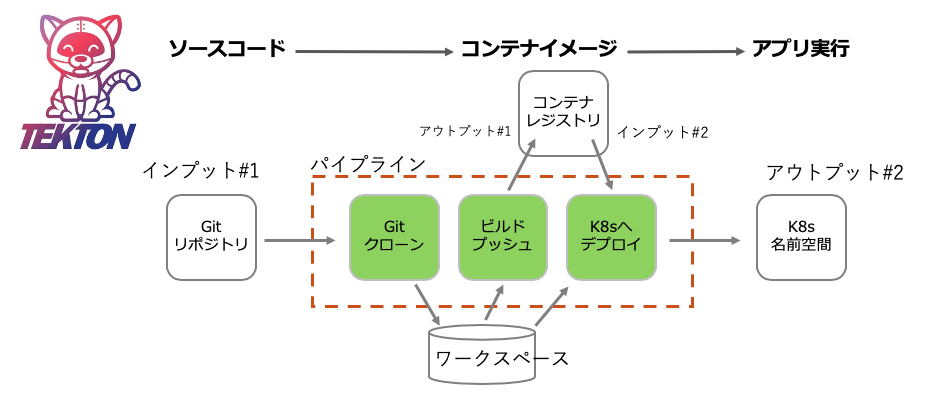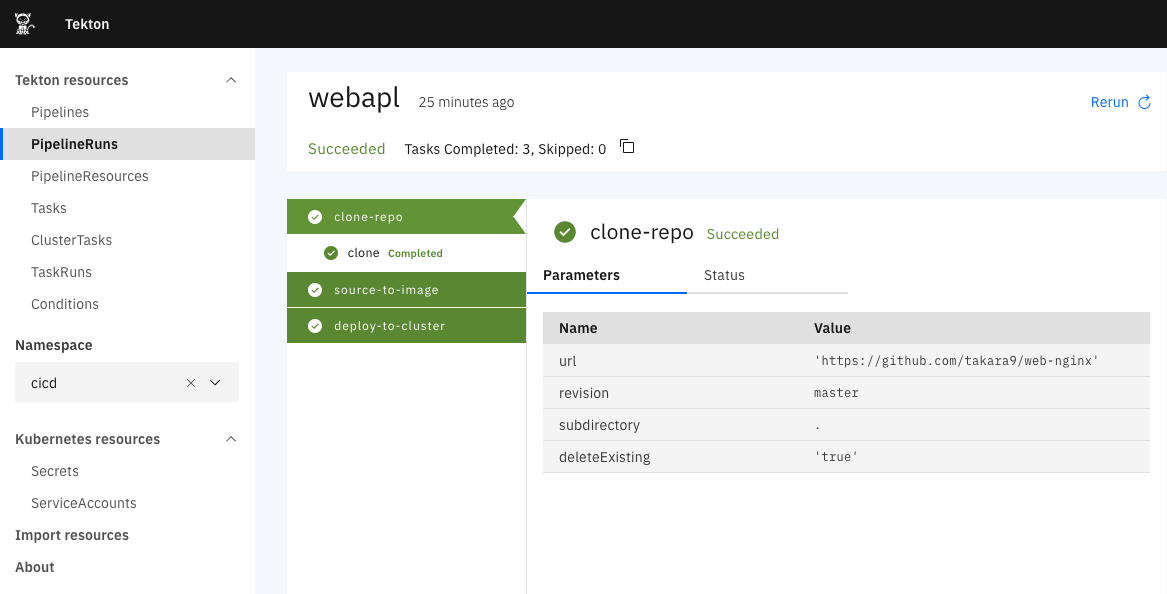Tektonは歴史が浅いためか、Jenkinsと比較すると、機能的な熟成度は、これからという感じがする。しかし、クラウドネイティブを推進する上では、Kubernetesのために作られたCIツールでもあり、今後発展するであろう抑えておきたい重要ツールだ。そこで、Tektonを使って、GitHub https://github.com/takara9/web-nginx のリポジトリからクローンして、コンテナをビルドした後コンテナレジストリへ登録、Kubernetesへデプロイする一連のパイプラインを、参考資料を読みながらつくってみた。
今回実現するCICDパイプライン
今回、目指すTektonパイプラインは、次の図の様なシンプルなものとする。パイプラインの中には、3つのタスクがある。
環境準備作業
ここでは、Tektonパイプラインを使用するための準備として、専用名前空間の作成とデフォルト名前空間の変更、IBMレジストリサービスからコンテナイメージをプルするための設定を実施する。
K8sクラスタ準備とTektonのインストール
今回は 諸般の都合により、IBM Cloud Kubernetes Service (IKS)を利用したが、OpenShiftでも同じことができる。Kubernetesクラスタは、Terraformで書かれた マルチゾーン HCL と Kubernetes HCL を IBM Cloud Schematic でリソース管理する形で起動した。本題とは関係ないので、これは別の機会にQiitaの記事にしたい。
Tektonのデプロイのために、以下のマニフェストを実行する。
$ kubectl apply --filename https://storage.googleapis.com/tekton-releases/pipeline/previous/v0.11.1/release.yaml
専用のネームスペースを作成
tekon専用の名前空間cicdを作成して、デフォルトの名前空間にcicdを指定する。
$ kubectl create ns cicd
$ kubectl config get-contexts | grep `kubectl config current-context`
$ kubectl config set-context cicd --namespace=cicd --cluster=<CLUSTER> --user=<AUTHINFO>
$ kubectl config use-context cicd
IBM コンテナレジストリへの登録する権限を付与
名前空間cicdを作成することで、サービスアカウント default が作成される。このサービスアカウントに設定が無ければ、IBM コンテナレジストリにアクセスができない。そのため、設定値を追加する作業を実施する。
$ kubectl get serviceaccount
NAME SECRETS AGE
default 1 23h
pipeline-account 2 19h
下記のサービスアカウントdefaultの設定で、「Image pull secrets」の値が「none」となっているため、IBMレジストリサービスからコンテナ・イメージをプルすることができない。この値には、コンテナレジストリにアクセスするためのキーが入ったシークレットの名前が設定されている必要がある。
$ kubectl describe serviceaccount default
Name: default
Namespace: cicd
Labels: <none>
Annotations: <none>
Image pull secrets: <none>
Mountable secrets: default-token-5j8cp
Tokens: default-token-5j8cp
Events: <none>
IBM Cloud の Kubernetesサービスでは、名前空間 default に プライベートのコンテナレジストリサービスから、イメージをプルするためのシークレットが設定される。
その内容は、以下の様にして確認することができる。 この中で、icr-ioと表示されたものが、各地域のIBMクラウドデータセンターに配置されたレジストリサービスである。
$ kubectl get secret -n default
NAME TYPE DATA AGE
all-icr-io kubernetes.io/dockerconfigjson 1 2d10h
default-au-icr-io kubernetes.io/dockerconfigjson 1 2d10h
default-de-icr-io kubernetes.io/dockerconfigjson 1 2d10h
default-icr-io kubernetes.io/dockerconfigjson 1 2d10h
default-jp-icr-io kubernetes.io/dockerconfigjson 1 2d10h
default-token-7g4x7 kubernetes.io/service-account-token 3 2d10h
default-uk-icr-io kubernetes.io/dockerconfigjson 1 2d10h
default-us-icr-io kubernetes.io/dockerconfigjson 1 2d10h
<以下省略>
上記の中で、all-icr-io のシークレットが、Tektonパイプラインを実行したい名前空間にあれば良いので、次のコマンドでコピーする。それに加えて、YAMLに埋め込まれた名前空間名をsedでdefaultをcicdに書き換える。
$ kubectl get secret all-icr-io -n default -o yaml | sed 's/default/cicd/g' | kubectl create -n cicd -f -
次に名前空間cicdのサービスアカウントdefaultにパッチを当てて、コピーしたシークレットの名前をセットする。
$ kubectl patch -n cicd serviceaccount/default -p '{"imagePullSecrets":[{"name": "all-jp-icr-io"}]}'
$ kubectl describe serviceaccount default
Name: default
Namespace: cicd
Labels: <none>
Annotations: <none>
Image pull secrets: cicd-jp-icr-io <---- default名前空間からコピーしたシークレット名
Mountable secrets: default-token-5j8cp
Tokens: default-token-5j8cp
Events: <none>
以上で専用名前空間と関連する設定が完了した。
テクトン・パイプラインの構築
Gitからマニフェストをクローンする
ここで利用するマニフェストは次のURL https://github.com/takara9/tekton-pipeline-1 からクローンできる。これらは、Tekton Catalog や Tutolial から収集したファイルなので、出処はファイルのヘッダー部分にメモしてある。
$ git clone https://github.com/takara9/tekton-pipeline-1 tp1
$ cd tp1
タスクの作成
次にTektonパイプラインを構成するタスクを設定する。このタスクに対するパラメーターは、パイプラインとパイプライン・ランから与えるので、タスクについて変更する必要はない。タスクの雛形は、tektonカタログ https://github.com/tektoncd/catalog に様々なタスクが準備されている。とりあえずパイプラインを構成する場合、このタスク・カタログから選んでくれば良い。
$ kubectl apply -f task-git-clone.yaml
$ kubectl apply -f task-kaniko.yaml
$ kubectl apply -f task-deploy-using-kubectl.yaml
タスクを作成した結果は、以下のコマンドで確認できる。
$ kubectl get task
NAME AGE
deploy-using-kubectl 22h
git-clone 22h
kaniko 22h
パイプラインの作成
タスクの登録ができたので、各タスクを繋ぐためのパイプラインを設定する。
今回、目的とするパイプラインは、次の3ステップである。
(1) コンテナをビルドするための材料となるコードをGitHubレジストリから取得
(2) コンテナ・イメージをビルドとコンテナ・レジストリへ登録
(3) Kubenetesの名前空間cicdへデプロイして実行
各ステップに相当するタスクの作成は上記で完了している。次に、パイプラインをYAMLを作成する。
このパイプラインは、パラメータを与えてタスクを順次実行するためのもので、このパイプラインに加え「kind: PipelineRun」からパラメータを与えて実行となる。
apiVersion: tekton.dev/v1beta1
kind: Pipeline
metadata:
name: build-and-deploy-pipeline
spec:
workspaces:
- name: git-source
description: The git repo
# パラメータセクション 実行時に Kind: PipelineRun から変数を与える。
params:
- name: gitUrl
description: Git repository url
- name: gitRevision
description: Git revision to check out
default: master
- name: pathToContext
description: The path to the build context, used by Kaniko - within the workspace
default: src
- name: pathToYamlFile
description: The path to the yaml file to deploy within the git source
- name: imageUrl
description: Image name including repository
- name: imageTag
description: Image tag
default: "latest"
tasks:
# ステップ #1
# GitHubからソースコードをワークスペースにクローン(取得)する
- name: clone-repo
taskRef:
name: git-clone
workspaces:
- name: output
workspace: git-source
params:
- name: url
value: "$(params.gitUrl)"
- name: revision
value: "$(params.gitRevision)"
- name: subdirectory
value: "."
- name: deleteExisting
value: "true"
# ステップ #2
# コンテナのビルドとレジストリへ登録 Kanikoタスクにパラメータを渡してビルド実行、イメージをレジストリへ登録
- name: source-to-image
taskRef:
name: kaniko
runAfter:
- clone-repo
workspaces:
- name: source
workspace: git-source
params:
- name: CONTEXT
value: $(params.pathToContext)
- name: IMAGE
value: $(params.imageUrl):$(params.imageTag)
# ステップ #3
# レジストリサービスに登録された コンテナ・イメージを K8sへデプロイする
- name: deploy-to-cluster
taskRef:
name: deploy-using-kubectl
workspaces:
- name: git-source
workspace: git-source
params:
- name: pathToYamlFile
value: $(params.pathToYamlFile)
- name: imageUrl
value: $(params.imageUrl)
- name: imageTag
value: $(params.imageTag)
- name: imageDigest
value: $(tasks.source-to-image.results.IMAGE-DIGEST)
次にパイプラインを登録する。
$ kubectl apply -f pipeline-build-and-deploy.yaml
次のコマンドでパイプラインの登録を確認できる。 これで、このパイプラインに「kind: PipelineRun」からパラメータを与えて、何度でも実行することができる。
$ kubectl get pipeline
NAME AGE
build-and-deploy-pipeline 22h
レジストリへのアクセス用シークレット作成
Kanikoタスクから、プライベートなコンテナレジストリにイメージを登録するために、シークレットを登録する。 シークレットのの取得には、IBM クラウドのウェブコンソール画面の「管理」->「アクセス(IAM)」->「APIキー」と進んで、「IBM Cloud APIキーの作成」をクリックしてキーを取得する。そして、シークレットに与えるアノテーション には、東京リージョンのレジストリを利用する場合「jp.icr.io」を設定する。
$ kubectl create secret generic ibm-registry-secret --type="kubernetes.io/basic-auth" --from-literal=username=iamapikey --from-literal=password=<API-KEY>
$ kubectl annotate secret ibm-registry-secret tekton.dev/docker-0=<REGISTRY>
ワークスペース用の永続ボリューム作成
パイプライン実行のために必要なアプリケーションのソースコード、生成オブジェクトを一時保存するための領域となるワークスペース用のボリュームを作成する。
$ kubectl apply -f pipeline-ws-pvc.yaml
サービスアカウントの作成と権限付与
Tektonパイプラインの実行に必要な権限を与えるために、サービスアカウントの作成と、役割ベースの権限をサービスアカウントへ付与する。
$ kubectl apply -f pipeline-sa-and-rbac.yaml
パイプライン実行
これであとは、パイプラインを実行して、ソースコードからデプロイまでの実行するだけとなった。このPipelineRunでは、既に登録済みのパイプライン名とパラメータを設定する。このファイルを apply することで、パイプラインのタスクが順次実行される。
apiVersion: tekton.dev/v1beta1
kind: PipelineRun
metadata:
name: webapl
spec:
# 利用するパイプラインを指定
pipelineRef:
name: build-and-deploy-pipeline
params:
# パラメータ
# この値が最終的にタスクに渡されて、各タスクが実行する
#
# ソースコードやDockerfileの GitHubリポジトリ
- name: gitUrl
value: https://github.com/takara9/web-nginx
# ビルドコンテキストを設定 GitHubのディレクトリ構造に合わせて値を変更
- name: pathToContext
value: .
# K8sへデプロイする時のマニフェスト この中にも変数を渡すのでTekton用の作成したマニフェストが必要
# 前述のGitからクローンする中に、値のファイルが入っている必要がある
- name: pathToYamlFile
value: "kubernetes/web-nginx.yaml"
# コンテナ・レジストリのURL、名前空間、リポジトリ名を設定
- name: imageUrl
value: jp.icr.io/takara/web-nginx
# リポジトリに登録する時のタグを設定
- name: imageTag
value: "1.0"
# パイプライン実行用のサービスアカウント、RBACで権限付与済み
serviceAccountName: pipeline-account
# ワークスペースとなるPVCの指定
workspaces:
- name: git-source
persistentVolumeClaim:
claimName: workspace-source-pvc
次のコマンドで実行を開始する。このパイプラインでおよそ10分くらいで、アプリケーションがデプロイされる。
$ kubectl apply -f pipelinerun-apl.yaml
実行経過確認
以下の実行ログは、パイプライン実行開始から終了までの経過である。ポッドの記録から、Tektonの各ステップはポッドであるという説明がよく解る。ここでは、各タスクを担う3つのポッドが実行されていることが解る。
$ kubectl apply -f pipelinerun-apl.yaml
pipelinerun.tekton.dev/webapl created
$ kubectl get pipelinerun
NAME SUCCEEDED REASON STARTTIME COMPLETIONTIME
webapl Unknown Running 8s
$ kubectl get pod -w
NAME READY STATUS RESTARTS AGE
affinity-assistant-7abf84d7a3-0 1/1 Running 0 11s
webapl-clone-repo-n5pt9-pod-77t5w 0/1 Init:0/3 0 11s
webapl-clone-repo-n5pt9-pod-77t5w 0/1 Init:1/3 0 66s
webapl-clone-repo-n5pt9-pod-77t5w 0/1 Init:2/3 0 67s
webapl-clone-repo-n5pt9-pod-77t5w 0/1 PodInitializing 0 68s
webapl-clone-repo-n5pt9-pod-77t5w 1/1 Running 0 69s
webapl-clone-repo-n5pt9-pod-77t5w 1/1 Running 0 69s
webapl-clone-repo-n5pt9-pod-77t5w 0/1 Completed 0 74s
webapl-source-to-image-5wkzr-pod-88kfn 0/3 Pending 0 0s
webapl-source-to-image-5wkzr-pod-88kfn 0/3 Pending 0 0s
webapl-source-to-image-5wkzr-pod-88kfn 0/3 Init:0/4 0 0s
webapl-source-to-image-5wkzr-pod-88kfn 0/3 Init:1/4 0 18s
webapl-source-to-image-5wkzr-pod-88kfn 0/3 Init:2/4 0 19s
webapl-source-to-image-5wkzr-pod-88kfn 0/3 Init:3/4 0 20s
webapl-source-to-image-5wkzr-pod-88kfn 0/3 PodInitializing 0 21s
webapl-source-to-image-5wkzr-pod-88kfn 3/3 Running 0 27s
webapl-source-to-image-5wkzr-pod-88kfn 3/3 Running 0 27s
webapl-source-to-image-5wkzr-pod-88kfn 2/3 Running 0 103s
webapl-source-to-image-5wkzr-pod-88kfn 0/3 Completed 0 104s
webapl-deploy-to-cluster-xpmj7-pod-8wtfn 0/2 Pending 0 0s
webapl-deploy-to-cluster-xpmj7-pod-8wtfn 0/2 Pending 0 0s
webapl-deploy-to-cluster-xpmj7-pod-8wtfn 0/2 Init:0/2 0 0s
webapl-deploy-to-cluster-xpmj7-pod-8wtfn 0/2 Init:1/2 0 1s
webapl-deploy-to-cluster-xpmj7-pod-8wtfn 0/2 PodInitializing 0 2s
webapl-deploy-to-cluster-xpmj7-pod-8wtfn 2/2 Running 0 6s
webapl-deploy-to-cluster-xpmj7-pod-8wtfn 2/2 Running 0 6s
webapl-deploy-to-cluster-xpmj7-pod-8wtfn 1/2 Running 0 8s
web-nginx-58dbcb78c6-9cl6s 0/1 Pending 0 0s
web-nginx-58dbcb78c6-9cl6s 0/1 Pending 0 1s
web-nginx-58dbcb78c6-9cl6s 0/1 ContainerCreating 0 1s
webapl-deploy-to-cluster-xpmj7-pod-8wtfn 0/2 Completed 0 10s
affinity-assistant-7abf84d7a3-0 1/1 Terminating 0 3m10s
affinity-assistant-7abf84d7a3-0 0/1 Terminating 0 3m10s
web-nginx-58dbcb78c6-9cl6s 1/1 Running 0 2s
affinity-assistant-7abf84d7a3-0 0/1 Terminating 0 3m18s
affinity-assistant-7abf84d7a3-0 0/1 Terminating 0 3m18s
$ kubectl get pipelinerun
NAME SUCCEEDED REASON STARTTIME COMPLETIONTIME
webapl True Succeeded 9m29s 6m20s
Tekton CLIの利用
Tektonの専用CLIが提供されている。まだまだ発展途上な感じだが、ログの表示は、デバックに役立つと感じた。
インストール方法は https://github.com/tektoncd/cli#installing-tkn にある。
次は、Tektonの管理用コマンドの実行結果である。kubectlコマンドが実行できる環境があれば tkn は実行できる。
$ tkn pipelinerun describe webapl
Name: webapl
Namespace: cicd
Pipeline Ref: build-and-deploy-pipeline
Service Account: pipeline-account
Timeout: 1h0m0s
Labels:
tekton.dev/pipeline=build-and-deploy-pipeline
🌡️ Status
STARTED DURATION STATUS
7 minutes ago 3 minutes Succeeded
📦 Resources
No resources
⚓ Params
NAME VALUE
∙ gitUrl https://github.com/takara9/web-nginx
∙ pathToContext .
∙ pathToYamlFile kubernetes/web-nginx.yaml
∙ imageUrl jp.icr.io/takara/web-nginx
∙ imageTag 1.0
🗂 Taskruns
NAME TASK NAME STARTED DURATION STATUS
∙ webapl-deploy-to-cluster-xpmj7 deploy-to-cluster 4 minutes ago 11 seconds Succeeded
∙ webapl-source-to-image-5wkzr source-to-image 5 minutes ago 1 minute Succeeded
∙ webapl-clone-repo-n5pt9 clone-repo 7 minutes ago 1 minute Succeeded
次の同じ tkn コマンドのログの表示結果である。
tkn pipeline logs は、タスクの途中で、異常終了となった場合、メッセージが親切なので、デバッグに有用と感じた。
$ tkn pipeline logs build-and-deploy-pipeline -L
[clone-repo : clone] + CHECKOUT_DIR=/workspace/output/.
[clone-repo : clone] + '[[' true '==' true ]]
[clone-repo : clone] + cleandir
[clone-repo : clone] + '[[' -d /workspace/output/. ]]
[clone-repo : clone] + rm -rf /workspace/output/./Dockerfile /workspace/output/./Jenkinsfile /workspace/output/./README.md /workspace/output/./html /workspace/output/./image-digest /workspace/output/./image-digested /workspace/output/./kubernetes /workspace/output/./nginx /workspace/output/./version
[clone-repo : clone] + rm -rf /workspace/output/./.git
[clone-repo : clone] + rm -rf '/workspace/output/./..?*'
[clone-repo : clone] + test -z
[clone-repo : clone] + test -z
[clone-repo : clone] + test -z
[clone-repo : clone] + /ko-app/git-init -url https://github.com/takara9/web-nginx -revision master -refspec -path /workspace/output/. '-sslVerify=true' '-submodules=true' -depth 1
[clone-repo : clone] {"level":"info","ts":1594038970.0260096,"caller":"git/git.go:136","msg":"Successfully cloned https://github.com/takara9/web-nginx @ a2c3c44412611c2fad66964270639f28d25a33bc (grafted, HEAD, origin/master) in path /workspace/output/."}
[clone-repo : clone] {"level":"info","ts":1594038970.0757568,"caller":"git/git.go:177","msg":"Successfully initialized and updated submodules in path /workspace/output/."}
[clone-repo : clone] + cd /workspace/output/.
[clone-repo : clone] + git rev-parse HEAD
[clone-repo : clone] + tr -d '\n'
[clone-repo : clone] + RESULT_SHA=a2c3c44412611c2fad66964270639f28d25a33bc
[clone-repo : clone] + EXIT_CODE=0
[clone-repo : clone] + '[' 0 '!=' 0 ]
[clone-repo : clone] + echo -n a2c3c44412611c2fad66964270639f28d25a33bc
[source-to-image : build-and-push] E0706 12:37:20.190084 14 aws_credentials.go:77] while getting AWS credentials NoCredentialProviders: no valid providers in chain. Deprecated.
[source-to-image : build-and-push] For verbose messaging see aws.Config.CredentialsChainVerboseErrors
[source-to-image : build-and-push] INFO[0040] Resolved base name nginx:latest to build
[source-to-image : build-and-push] INFO[0040] Retrieving image manifest nginx:latest
[source-to-image : build-and-push] INFO[0043] Retrieving image manifest nginx:latest
[source-to-image : build-and-push] INFO[0046] Retrieving image manifest nginx:latest
[source-to-image : build-and-push] INFO[0049] Retrieving image manifest nginx:latest
[source-to-image : build-and-push] INFO[0052] Built cross stage deps: map[0:[/html /etc/nginx/conf.d/default.conf]]
[source-to-image : build-and-push] INFO[0052] Retrieving image manifest nginx:latest
[source-to-image : build-and-push] INFO[0054] Retrieving image manifest nginx:latest
[source-to-image : build-and-push] INFO[0057] Executing 0 build triggers
[source-to-image : build-and-push] INFO[0057] Unpacking rootfs as cmd COPY ./html /html requires it.
[source-to-image : build-and-push] INFO[0061] COPY ./html /html
[source-to-image : build-and-push] INFO[0061] Taking snapshot of files...
[source-to-image : build-and-push] INFO[0061] COPY ./nginx/default.conf /etc/nginx/conf.d/default.conf
[source-to-image : build-and-push] INFO[0061] Taking snapshot of files...
[source-to-image : build-and-push] INFO[0061] Saving file html for later use
[source-to-image : build-and-push] INFO[0061] Saving file etc/nginx/conf.d/default.conf for later use
[source-to-image : build-and-push] INFO[0061] Deleting filesystem...
[source-to-image : build-and-push] INFO[0061] Retrieving image manifest nginx:latest
[source-to-image : build-and-push] INFO[0063] Retrieving image manifest nginx:latest
[source-to-image : build-and-push] INFO[0067] Executing 0 build triggers
[source-to-image : build-and-push] INFO[0067] Unpacking rootfs as cmd COPY --from=build /html /usr/share/nginx/html requires it.
[source-to-image : build-and-push] INFO[0070] COPY --from=build /html /usr/share/nginx/html
[source-to-image : build-and-push] INFO[0070] Taking snapshot of files...
[source-to-image : build-and-push] INFO[0070] COPY --from=build /etc/nginx/conf.d/default.conf /etc/nginx/conf.d/default.conf
[source-to-image : build-and-push] INFO[0070] Taking snapshot of files...
[source-to-image : digest-to-results] + cat ./image-digested
[source-to-image : digest-to-results] + tee /tekton/results/IMAGE-DIGEST
[source-to-image : digest-to-results] + jq .[0].value -rj
[source-to-image : digest-to-results] sha256:226a53d7b56e605a6378e410a541af8f83696236ad22de2c3d13ff65bbfe2f09
[deploy-to-cluster : run-kubectl] deployment.apps/web-nginx created
[deploy-to-cluster : run-kubectl] service/web-nginx unchanged
Tekton ダッシュボード
まだ表示くらいの機能しかないが、Tekton ダッシュボード https://tekton.dev/docs/dashboard/ が提供される。マニフェストを適用するだけでダッシュボードが利用できる。 Tektonのリソース構造から、参照していけるので、これを利用すると、Tektonの構造把握が早くなる。
kubectl apply --filename https://github.com/tektoncd/dashboard/releases/latest/download/tekton-dashboard-release.yaml
ユーザー管理や認証の機能が無いので、Ingressの下で動かすか、それとも、port-foward で利用する。
$ kubectl --namespace tekton-pipelines port-forward svc/tekton-dashboard 9097:9097
感想
CICDツールと言えば、重厚長大で歴史がある Jenkins と比較してしまう。 そうすと Tektonは コンパクトで軽くセットアップも用意な感じがした。もちろん、パイプラインを構築する手間は、どちらも変わらないが、CIツールとしての機能と便利さは、まだまだ Jenkins の方が上だと感じる。しかし、最初からコンテナ用として設計されているので、今後の発展に期待したい。

